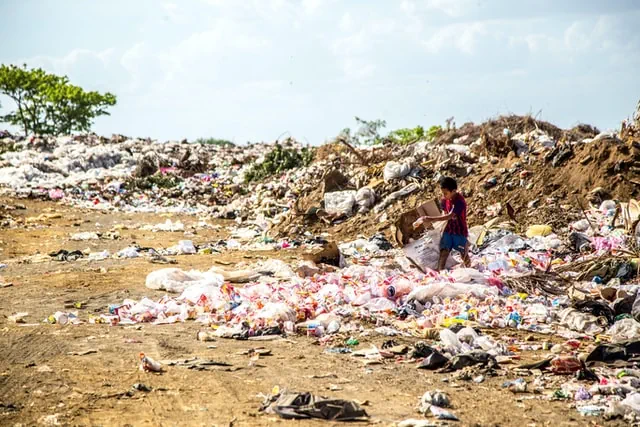
The Effects Of Landfills On The Environment

Table of Contents
Every day, the average person in the U.S. throws about 4.9 pounds of municipal solid waste (MSW). Of the 294.4 million tons of MSW collected in 2018, only 32.1% were composited and recycled. About 17.7 million tons of food waste were managed in other ways, but 50% of the waste (146 million tons) ended up spread across the over 2600 MSW landfill plants in the country.
What’s a Landfill?
Landfills are the most common way of waste disposal worldwide, as people don’t concern themselves with what they can’t see. That’s great for the land’s aesthetics, but it poses a significant risk to the environment when communities ignore proper sitting. Fortunately, some landfills are engineered with integrated waste management systems that obviate leachates’ hazards, greenhouse gases, and other toxins.
When left unattended, landfills result in land pollution, and the toxins released in the soil have become a critical global health issue. Even worse, most of this waste is dumped near lakes, oceans, and rivers, posing severe risks to animals, people, and the general environment. Here are the leading causes of landfills and their effects on the environment.

Effects of landfills on our environment
Major Causes of Landfills
Solid Waste
Solid waste is the main contributor to the creation of landfills worldwide. Homes, restaurants, schools, offices, and public places produce many used materials, rubbish, and garbage. The waste products include paper, wood, plastic, and obsolete electronic products, which are dumped in landfills.
Because most of the waste products are not biodegradable, they lay in landfills for years. The result is worse in poorly managed landfills, as the waste damages the land and the environment.

Solid waste garbage - Pixabay
Agricultural Waste
Waste materials from crops, animal manure, and farm waste are also collected and dumped in landfills. Most of these agricultural remains release highly toxic substances as they decompose and contaminate water resources and land.
Manufacturing, Industry, and Construction Waste
Construction activities, industrial processes, and power plants produce lots of byproducts and solid residues. The main waste products are generated by power plants, oil refineries, pharmaceuticals, agricultural products, and construction works. Unfortunately, this solid waste eventually finds it’s way to different landfills from time to time.

Industrial Waste. Source: Pixabay
Urbanization
Population growth and urbanization is a significant reason why landfills have increased over the last few years. With the urban growth and increase in income levels, the demand for processed products and manufacturing material has increased. As such, experts predict that high-income countries will experience a 19% increase in waste generation, while low- and middle-income countries grow by about 40%.
In particular, plastic waste will triple in the fastest growing regions of South Asia, Sub-Saharan Africa, North Africa, and the Middle East by 2050. That is because rapid urbanization and an increase in population contribute to an increase in demand for plastics that account for about 80% of municipal solid waste.
Serious Effects of Landfills on the Environment
Air Pollution a Major Concern
Landfills emit over ten toxic gases, with methane being the most fatal. Methane is naturally produced in activities involving organic matter decay from different sources. According to EPA, MSW landfills accounted for over 15% of methane emissions in the USA in 2018. Compared to greenhouse gas emissions during the same year, these methane amounts are equal to emissions released by over 20 million passenger vehicles driven over the year.
The methane released from unmanaged decomposing organic matter in landfills can also trap solar radiation 20 times better than carbon dioxide. That results in increased global temperatures, especially in urban areas where most landfills are located. Besides methane, other agricultural and household chemicals like bleach find their way in landfills and generate toxic gases that highly affect the neighborhood’s air quality.
Groundwater Contamination
The contamination of groundwater by leaches is a significant concern arising from the increase in landfills globally. That’s because landfills are packed with hazardous waste that inevitably continues deteriorating groundwater, especially when it’s set near a lake, river, or ocean. These toxic materials range from household cleaners to industrial solvents and electronic waste that contain mercury, lead, and cadmium. Most of these landfill toxins penetrate the soil and reach fresh waterways, which sadly end up in the foods and water we consume. This pollution affects animal and plant life, as research shows that 82% of all landfills have leaks.

Poorly managed landfill near a river
Soil and Land Pollution
Landfills render the land and soil where it’s set unusable. It also affects the adjacent land because toxic chemicals can spread through the soil surrounding the area over time. These toxins destroy the soil’s upper layer, distort soil fertility, and affect the plants’ lives. That upsets the land’s ecosystem and can result in health complications if the soil is used for agricultural purposes.
Health Concerns
Unmanaged landfills pose the risk of severe health issues with low birth rates and weights, congenital disabilities, and increased cancer cases, especially for those residing near these plants. For example, TCE is a common carcinogenic substance that originates from landfill leachate and is associated with several adverse health effects. That includes immunotoxicity, neurotoxicity, several forms of cancer, developmental toxicity, and liver issues.
People living near landfills have also reported other symptoms and discomfort issues like fatigue, headaches, and sleepiness. These effects result from the toxic chemicals emitted by landfill waste. That includes everything from harmful gases to water contaminants that result in adverse health effects. In fact, over 50% of people living close to landfills suffer from lung and heart diseases at one point or the other.
Landfill Fires
Landfill gases and wastes can easily start fires, especially during sunny seasons. Once the fires ignite, stopping them can be challenging even with proper equipment, and it further contributes to air pollution. These fires can also destroy neighboring human and animal habitats if not put out immediately.
Methane gas is highly combustible, and it can wreak havoc when in abundant supply. In landfills, the combustion of this gas also worsens as it burns together with other chemicals that increase toxins in the area.
Economic costs
The social and economic cost of managing a landfill can be very high. From managing groundwater contamination to minimizing the number of harmful gasses emitted, there’s a lot that needs lots of finances to avoid future complications. Additionally, a municipality must incur additional costs in complying with environmental regulatory policies.
Since most material packed in landfills doesn’t easily decompose, it can be challenging to effectively design integrated waste management facilities and strategies with limited resources. These high capital investments drain the municipality funds and might encourage some communities to leave landfills unmanaged.
Is There A Solution To The Ailing Landfill Problem?
Besides the financial implications, buried waste in landfills slowly breaks down and results in more problems for future generations. Here are several impressive techniques that will help to consistently and reliably treat landfill wastes.
Designing and implementing integrated waste management systems
Modern landfills are well-engineered disposal facilities that significantly cut down the impact of waste on soil, water, and air. Well-designed landfills ensure they comply with environmental preservation requirements and ultimately help to create an environment free of contaminants. Such designs also ensure there are no landfills in environmentally-sensitive areas and feature onsite environmental monitoring systems to ensure that contamination can be detected and controlled easily.
Diverting waste from landfills
Unlike Carbon dioxide, which has a 100-to-300-year lifespan, methane stays in the atmosphere for around 12 years. That means focusing on reducing methane gas from landfills can be more effective in reducing climate change risk compared to reducing CO2. A practical approach for cutting down the methane levels in landfills is to reduce methane generating waste materials before they reach the site. That means dealing with plastics, household trash, and other organic materials like yard waste and food scraps before they reach landfills.
Research shows that almost 50% of the food grown and sold in the U.S is wasted. As such, diverting the waste food from landfills presents big opportunities. That’s because yard waste and food scraps can be turner into compost instead of taking them to landfills.
Reuse, Recycle and Reduce
Landfill management will always be a significant issue for communities that don’t embrace recycling, reuse, and reduce waste strategies. By incorporating recycling systems for plastics, metal, paper, electronics waste, and glass, municipalities can significantly reduce landfill waste. Reducing the demand for manufactured products also reduces the volume of waste and toxicity levels in landfills. That translates to avoiding wastage, rethinking our consumption needs, reusing products, and respecting the planet by living environmentally cautious lives.
Bottom Line
Improperly designed and managed landfills can result in unsanitary conditions that can lead to pollution and disease outbreaks. Landfills can also pose severe threats to the soil and groundwater resources. However, you can make a difference by reusing and recycling materials to reduce other products’ demand and maintain natural resources.